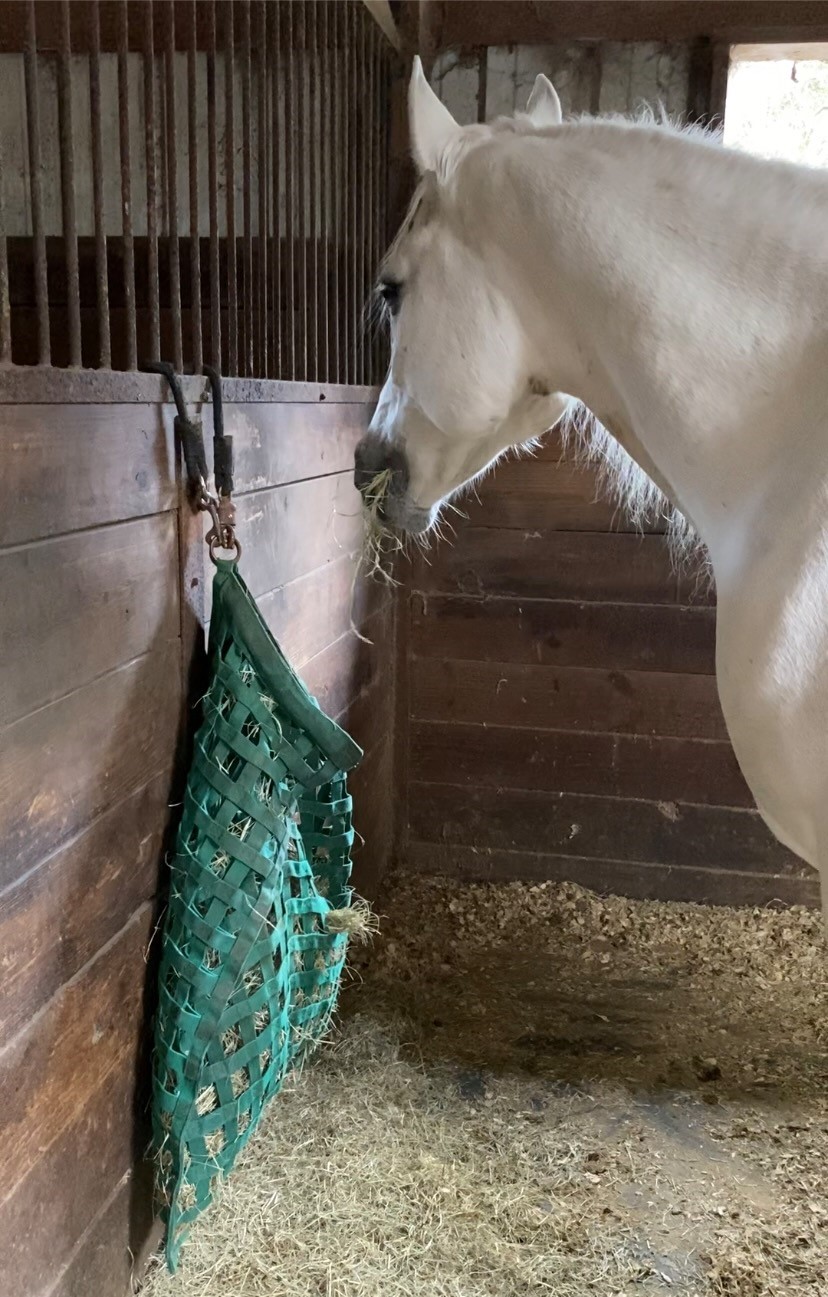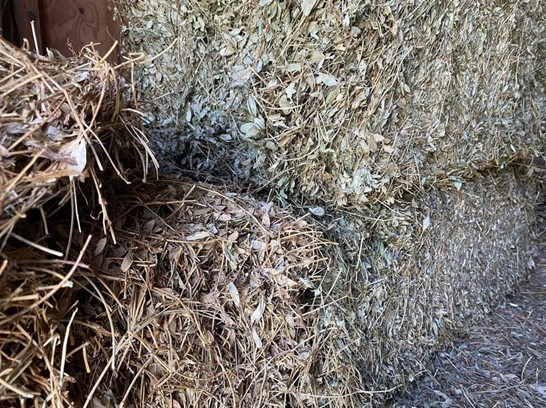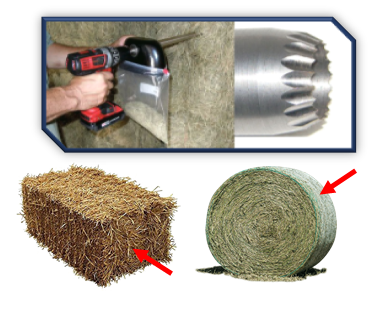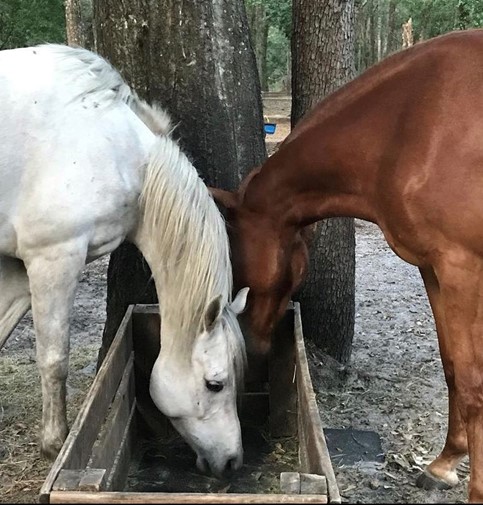Carissa Wickens, UF Department of Animal Sciences, and Carol Vasco, Post-doctoral Fellow, Auburn University Department of Animal Sciences

Hay or pasture should comprise at least half of a horse’s diet, and the nutritional requirements of horses for maintenance or in light work can be met largely by forages.Credit: Caraissa Wickens, UF/IFAS
Forages in the Horse’s Diet
Forage is an essential component in the diet of horses. Hay or pasture should comprise at least half of a horse’s diet, and the nutritional requirements of horses for maintenance or in light work can be met largely by forages. Effective use of forages in the nutritional management of horses can help reduce feeding costs, support gastrointestinal health, and promote normal foraging behavior for improved horse welfare.
While the winter weather in Florida is not nearly as extreme as it is in other parts of the country, when the daylength shortens and nighttime temperatures drop, our warm-season pastures (bahiagrass and bermudagrass) go dormant. The next couple of months mark a transition period during which forage production and nutritive value of warm-season forages in the pasture will be limited. Therefore, providing good quality hay is extremely important to assure horses are receiving enough forage and that we are meeting their nutrient requirements, particularly with young growing horses, lactating broodmares, and horses in intensive training or competition.
–
Assessing Hay Quality
Why should we test the hay? No matter which type of hay your horses have access to, it is extremely important to test those forages before feeding them. Regarding hay quality and selection, hay should be free of mold and dust and should not contain toxic weeds. Hay should smell fresh. Assessing hay quality on color alone can be misleading. Leafier hays (hay containing less stems) are typically higher in nutrients (leaves contain more digestible non-structural carbohydrates, protein, vitamins, and minerals than stems), but the only way to truly assess forage quality is to collect and submit samples to a lab for chemical analysis. Forage testing provides useful information on the nutritive value of the forage, which can help you determine if supplementation is required. This information allows you to better meet your horses’ nutritional needs and prevent under or overfeeding. You can consult with a horse nutritionist for assistance in balancing your horse’s diet based on the forage quality you have available.

The bales of perennial peanut on the right side of the image are much leafier and have finer stems than those on the left. The bales on the right also have a brighter green color, but the leaf to stem ratio can provide a better indication of nutritive value of the hay. Credit: Carissa Wickens, UF/IFAS
–
Collecting a Forage Sample for Testing
- Representative sample: collect sample from several bales.
- Properly collecting and identifying a forage sample is very important (need to record the type of forage and the date the sample was collected)
 When collecting hay samples, take samples from at least 10 bales with a hay probe (you can contact your local county extension office for assistance with forage sample collection). When sampling a square bale, always collect samples from the smaller side (red arrow), and when collecting from round bales, always collect from the curved side (red arrow). This allows you to collect from multiple flakes or layers to achieve a representative sample from each bale. Place all collected samples in a bucket, mix the samples thoroughly, transfer approximately one pound to a plastic storage bag and send it immediately to the lab.
When collecting hay samples, take samples from at least 10 bales with a hay probe (you can contact your local county extension office for assistance with forage sample collection). When sampling a square bale, always collect samples from the smaller side (red arrow), and when collecting from round bales, always collect from the curved side (red arrow). This allows you to collect from multiple flakes or layers to achieve a representative sample from each bale. Place all collected samples in a bucket, mix the samples thoroughly, transfer approximately one pound to a plastic storage bag and send it immediately to the lab.
–
Where can hay samples be sent?
| Forage Extension Lab
3401 Experiment Station |
Waters Agricultural Lab
257 Newton Road |
730 Warren Road
|
UGA Feed & Environmental Water Lab
2300 College Station Rd |
–
Hay Selection and Purchasing tips
- Don’t buy hay with excessive dust or a musty smell, as this can indicate the presence mold. Dust and mold can be especially problematic for horses with respiratory problems (e.g., equine asthma or heaves).
- Grab a handful of the hay and give it a hard squeeze. If it hurts your hand, it is too stemmy and mature to be good quality horse hay.
- Look for seed heads in grass hay. If they are numerous, large, and well-formed, and there are large stems present, the hay is probably too mature and fibrous to be acceptable for horses.
- For legume hay, the presence of flowers and large stems are indicative of maturity, and this may not be of acceptable quality for your horse.
- Buy as much hay as possible at one time to provide a consistent supply to minimize changes in your horse’s forage supply. This can be a challenge for smaller equine farms as this requires a separate/adequate hay storage area. Planning purchases or delivery of hay before you are down to the last few bales is ideal, as this allows you to transition horses between batches of hay gradually over a period of 7-10 days.
- Purchase hay from a recommended source or supplier, preferably from someone who can provide a laboratory analysis of the hay.
–
Feeding Management

An example of a wooden feeder placed over a rubber mat to reduce wastage and to help minimize sand consumption during hay feeding. Credit: Carissa Wickens, UF/IFAS
How we feed hay during the winter and early spring months is also critical to help prevent wastage. Research conducted at the University of Minnesota has shown that feeding horses round bales without a feeder can result in up to 57% wasted hay, reduced hay intake, and weight loss in horses. Using feeders to avoid horses eating hay directly off the ground can also help prevent ingestion of sand reducing the risk of sand colic.
In times of hay shortage or for horses that have difficulty chewing and digesting long-stem forages, hay cubes can be used as an alternative forage source. Hay cubes can be made from a variety of coarsely chopped hays, but the most common are alfalfa and timothy-alfalfa cubes.
–
Advantages of hay cubes:
- Less storage space needed and easier to handle
- Decreased feeding waste
- Adequate particle size to maintain normal digestive health
–
Guidelines for feeding hay cubes:
- Feed hay cubes in a feeder close to the ground as this encourages horses to chew cubes before swallowing
- Break cubes into small pieces or soak cubes with water to soften them before feeding to prevent choking
–
References and Further Reading
Warren, L. Selecting hay for your horse. Available at: Selecting Hay for Your Horse
Myer, B., L. Warren, J. Eckert, D. Hancock, A. Blount, and C. Olson. 2019. Perennial peanut: Forage nutritional composition and feeding value. EDIS publication AN234. Available at:
Martinson, K., W. Lazarus, and M. Hathaway. Feeding horses with a round-bale feeder. Reviewed in 2021.
- Paying Attention to What Comes Out:Forage Transitions and Free Fecal Water Syndrome in Horses - August 2, 2024
- Feeding Horses Grazing Bahiagrass Pastures for Maintenance with Minimal or Light Exercise - August 25, 2023
- Corneal Ulcers in Horses: The Importance of Keeping an Eye on Your Horse’s Eyes - May 5, 2023
